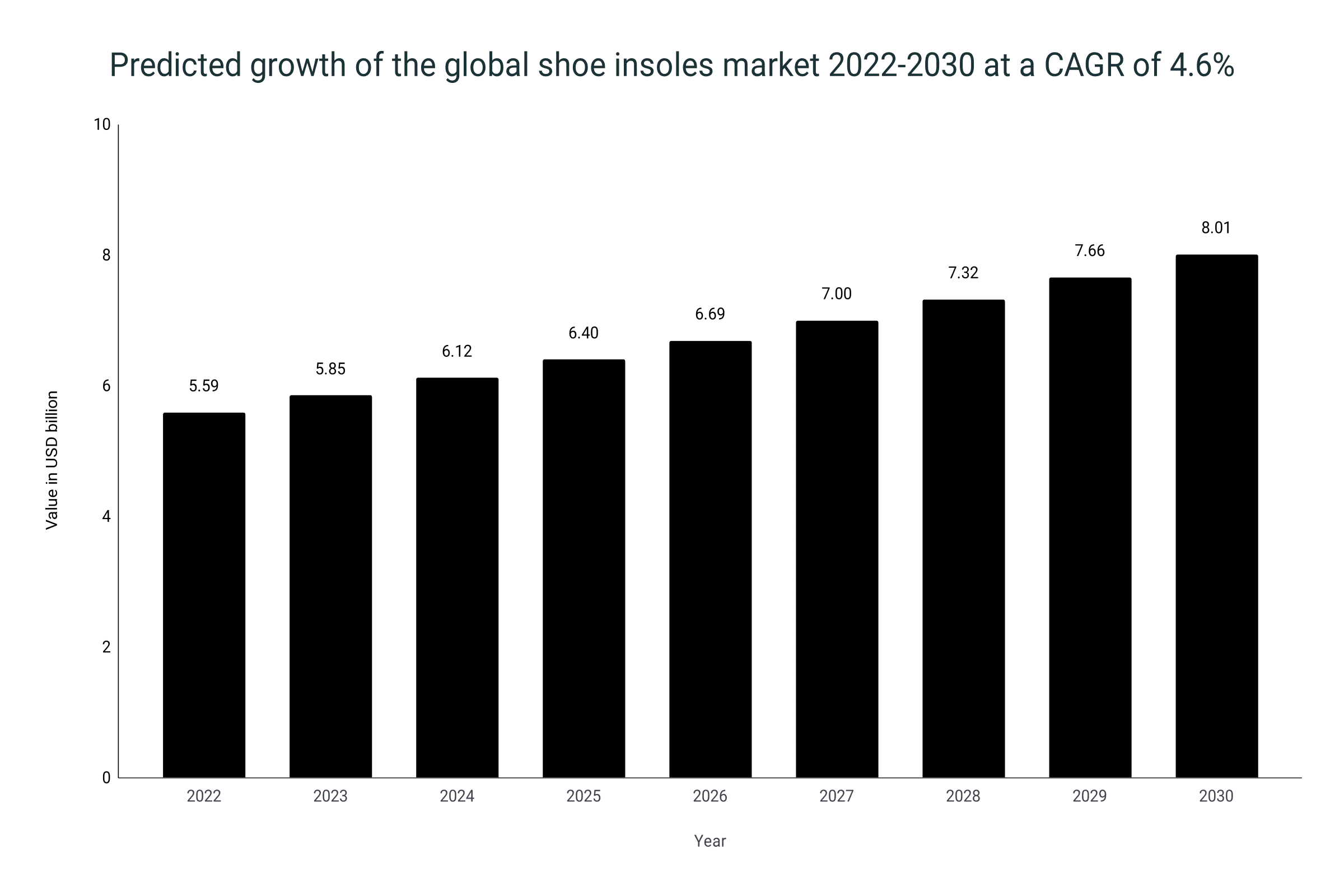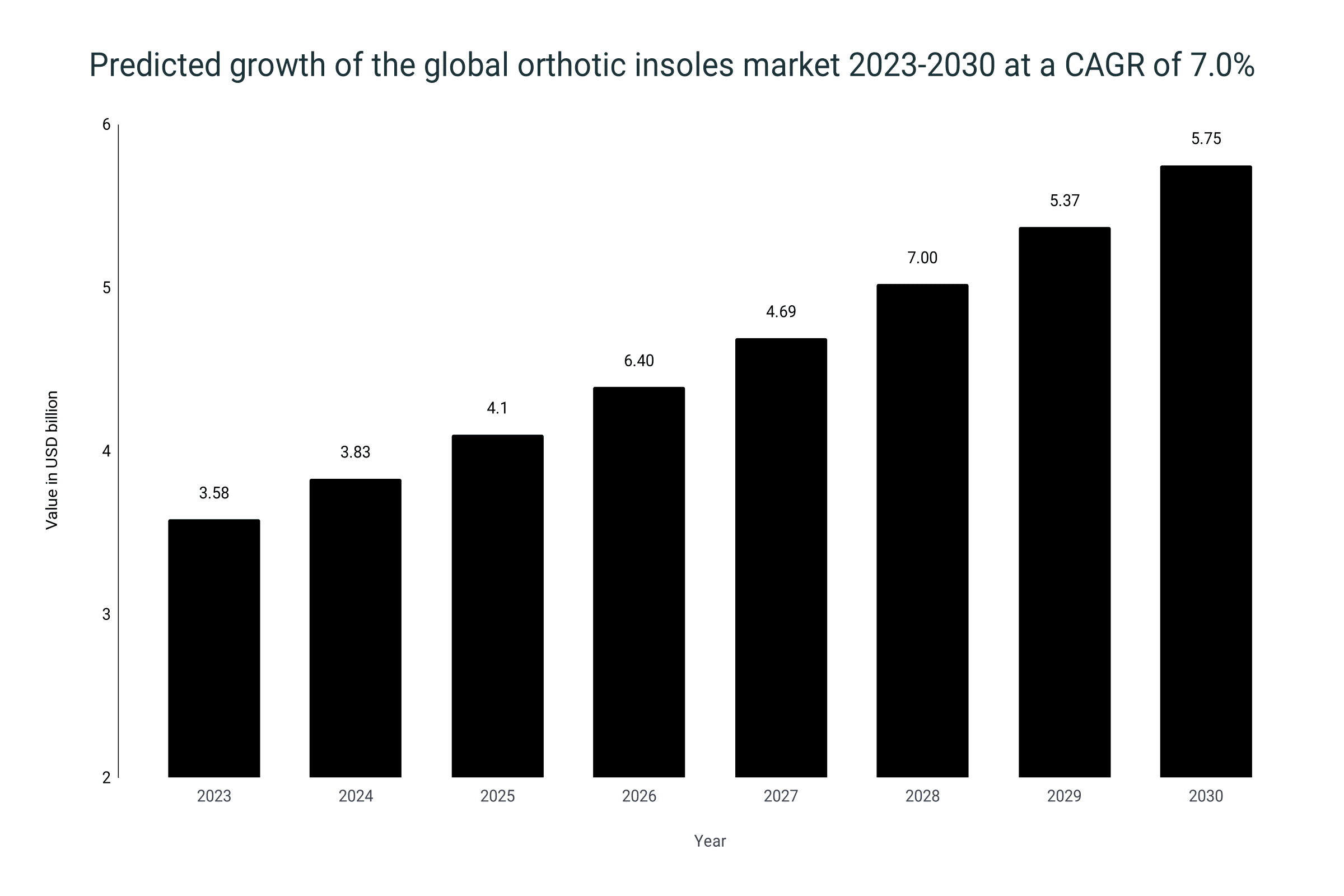Shoe Insoles and Orthotics Statistics
Terms like shoe insoles, inserts and orthotics are often used interchangeably. However, it’s important to highlight that orthotics are the most specialised of the three and are usually made by a podiatrist. Insoles and inserts are usually bought over the counter.
Shoe insoles and orthotics global market revenue statistics
- The global insole and orthotic shoe market is valued at $5.59 billion as of 2022.
- It is projected that the market will grow to $8.04 billion by 2030 at a CAGR of 4.6%.
- In 2021, the global shoe insoles market size was valued at USD 5.38 billion.
- Insoles for women dominated the market in 2021 with a revenue share of over 50%.
- The biggest material categories are foam, gel, and rubber. Foam dominated the global market in 2021 with a revenue share of over 45.0%. Rubber, on the other hand, is following the trend of accelerated growth and is expected to expand at a CAGR of 4.0% from 2022 to 2030.
- The largest market in 2021 was Asia Pacific, with a revenue share of over 45.0%. 2nd fastest growing market is Central and South America, with a predicted CAGR of 4.7% for the 2022-2030 period.
- When split into groups by application, there are casual insoles, athletic insoles, and orthotics. In 2021, orthotics occupied over 60% of the global market.
Predicted growth of the global shoe insoles market 2022-2030 (CAGR 4.6%)
|
Year |
Value (in USD billion) |
|
2022 |
5.59 |
|
2023 |
5.85 |
|
2024 |
6.12 |
|
2025 |
6.40 |
|
2026 |
6.69 |
|
2027 |
7.00 |
|
2028 |
7.32 |
|
2029 |
7.66 |
|
2030 |
8.04 |

Orthotic insoles market revenue
- The global orthotic insoles market size was valued at USD 3.36 billion in 2022.
- From 2023 to 2030, the global orthotics market is expected to grow at a CAGR of 7.0%, or from USD 3.58 billion to 5.78 billion.
- In the 2017-2021 period, this market grew at a CAGR of 5.4%.
Table: Predicted growth of the global orthotic insoles market from 2023 to 2030 (CAGR 7.0%)
|
Year |
Value (in USD billion) |
|
2023 |
3.58 |
|
2024 |
3.83 |
|
2025 |
4.10 |
|
2026 |
4.39 |
|
2027 |
4.69 |
|
2028 |
5.02 |
|
2029 |
5.37 |
|
2030 |
5.78 |

- In 2022, North America had a revenue share of 44.1% of the global orthotic insoles market, or USD 1.38 billion.
- North America’s orthotic insoles revenue is expected to grow at a CAGR of 6.8% in the 2023-2030 period.
Table: Predicted growth of North America’s orthotic insoles market revenue (CAGR: 6.8%)Chart: Predicted growth of North America’s orthotic insoles market revenue (CAGR: 6.8%)
|
Year |
Revenue (in USD billion) |
|
2022 |
1.38 |
|
2023 |
1.47 |
|
2024 |
1.57 |
|
2025 |
1.68 |
|
2026 |
1.80 |
|
2027 |
1.92 |
|
2028 |
2.05 |
|
2029 |
2.19 |
|
2030 |
2.34 |

Orthotics insoles market predictions by age
- The adult foot orthotic insoles segment is expected to account for 70% of sales through 2030.
- The prevalence of foot orthotic insole use rises with age. 88% of people between the ages of 85 and 95 are using them. 76% of people between the ages of 55 and 64 are using them.
- More than 50% of people suffering from foot pain are using foot orthotic insoles.
Orthotic insoles market by material and type
- Thermoplastic orthotics had a share of 56.0% in 2022 and are expected to grow at a CAGR of 6.9% from 2023 to 2030. Carbon fibre orthotics are expected to grow at a CAGR of 7.4% over the same period.
- It is projected that EVA (ethyl-vinyl-acetate) will remain the most preferred material, with 1/5th of the total market share through 2031.
- In 2019, there were 702.9 million people aged 65 and above. By 2050, this number is expected to grow to 1,548.9 million. This, along with a high incidence of plantar fasciitis and diabetes, is increasing the demand for orthotics.
- People with a diagnosis of diabetes are more likely to use foot orthotic insoles (86%).
- In 2022, custom-made orthotics took 54.4% of the market. This segment is expected to grow at a CAGR of 6.9% from 2023 to 2030. In 2021, Germany held a 23.8% share of the European custom foot orthotics market.
- Prefabricated orthotics, on the other hand, are anticipated to grow at a CAGR of 7.1% over the same period.
Orthotic insoles market by distribution channels
- Looking at the distribution channels, hospitals and clinics had the largest share in 2022: 39.9%. Drug stores had a share of 31.7% and others took 28.4% of the market.
- It is expected for the Hospitals and clinics segment to grow at a CAGR of over 7.0% from 2023 to 2030. Drug stores are expected to grow at a CAGR of 7.3%.
|
Distribution channel |
Market share in 2022 |
Expected CAGR for 2023-2030 period |
|
Hospitals and clinics |
39.9% |
7.0% |
|
Drug stores |
31.7% |
7.3% |
|
Others |
28.4% |
N/A |

How effective are insoles and orthotics?
- To prove that the insoles work: a study looked at participants who were given real insoles and placebo insoles. The average pain intensity before the use of insoles was 5.46. After the use of real insoles and placebo insoles, the average pain intensity decreased to 3.96 and 5.11, respectively. Those who were given real insoles had a significant change in reported pain intensity, unlike those who were given the placebo ones.
- Three-dimensional-printed insoles were given to 200 patients suffering from various foot-related problems and joint pain. Insoles were customised by density, heel cup, heel rise, medial arch height, and lateral wedge. Other podiatry elements were added for people with diabetes. These 3d insoles were effective in alleviating pain for more than 90% of the patients.
- Some orthotic materials can reduce plantar pressure during walking: polyurethane (including PORON), polyethylene (including Plastazote), and EVA.
- When evaluating orthotic insoles for people with diabetes who are at risk of first ulceration, a study has shown that plantar pressure relief is sensitive to orthotic insole design and individual patient feet.
- Customised orthotics, individually designed for people with flat feet, helped reduce body weight and BMI and made positive improvements in vertical jumps, the Cooper test and 30m sprints.
- Wearing arch support insoles decreased oxygen uptake and resulted in less muscle fatigue during downhill walking.
- Orthotic insoles prevent further deformation in flexible flat feet.
Facts about insoles and orthotics
- There are 4 types of partial shoe insoles that offer additional comfort: heel lifts, heel cups, metatarsal pads, and â length inserts.
- Insoles that offer additional arch support can be semi-rigid (somewhat flexible) and rigid (stiff). These insoles are mostly used for arch pain, plantar fasciitis, overpronation, and supination.
- Insoles that offer cushioned arch support (more cushioning than support) are mostly used for plantar fasciitis, all-day standing, metatarsalgia, foot fatigue, and shin splints.
- Insoles that offer additional comfort are used when people need more cushioning or some temporary relief. The most popular cases when these insoles are used are: taking pressure off Achilles and calves (heel lifts), heel pain and plantar fasciitis (heel cups), Morton’s neuroma (metatarsal pads), for more comfort in flats or dress shoes (â length insoles).
- Insoles often have a microfiber layer on top used for odour control.
Facts about different materials found in insoles and orthotics
- Foam is incredibly soft and used mainly for additional cushioning. It offers less support than plastic or carbon fibre insoles.
- Plastic is really stiff and is used mostly in rigid insoles. It’s strong, lightweight and offers maximal support.
- Carbon fibre is very stiff and offers maximal support. It is thinner and even lighter than the plastic insoles.
- Gel offers the best shock absorption, which is why it’s mostly found in insoles for cushioning. The downside is their heavy weight. They are great for sports (high-impact activities).
- Cork is mostly used for support, it is softer than plastic and carbon fibre but not squishy.
- Woll is mostly used for insulation or as an overlay to help with sweating and odour control.
- Wicking synthetic materials are usually found as a top layer or an overlay to help with moisture wicking.
FAQ
What’s the difference between shoe insoles and orthotics?
Insoles are mostly used for additional cushioning for comfort or pain and additional arch support. Orthotics are mainly created to help with complex foot conditions, serious biomechanical issues, and diabetes. Insoles offer none to minimal customization, can be bought over the counter, and usually cost $20-90. Orthotics are more durable, have a maximum level of customization (made for individual’s feet), and are usually created by podiatrists or orthopaedic surgeons.
What are insoles mostly used for?
Insoles are mostly used when people want to add comfort to their walking or running experience when they want to improve the fit of the shoes, reduce foot fatigue or plantar fascia strain, or need extra shock absorption.
What are orthotics mostly used for?
Orthotics usually treat foot pain, different types of injuries and foot conditions, diabetic foot ulcers, and painful calluses; they promote proper foot function and aid proper foot and lower leg alignment, and can control abnormal motion.
Do insoles and orthotics work in all shoes?
They work in shoes that have removable insoles so that the already-present insoles can be taken out and insoles/orthotics put inside.
Sources
https://www.mdpi.com/2673-1592/5/2/38
https://www.ncbi.nlm.nih.gov/pmc/articles/PMC3489231
https://jfootankleres.biomedcentral.com/articles/10.1186/s13047-019-0344-z
https://jfootankleres.biomedcentral.com/articles/10.1186/s13047-020-00401-3
https://www.grandviewresearch.com/industry-analysis/shoe-insoles-market-report
https://www.grandviewresearch.com/industry-analysis/foot-orthotic-insoles-market
